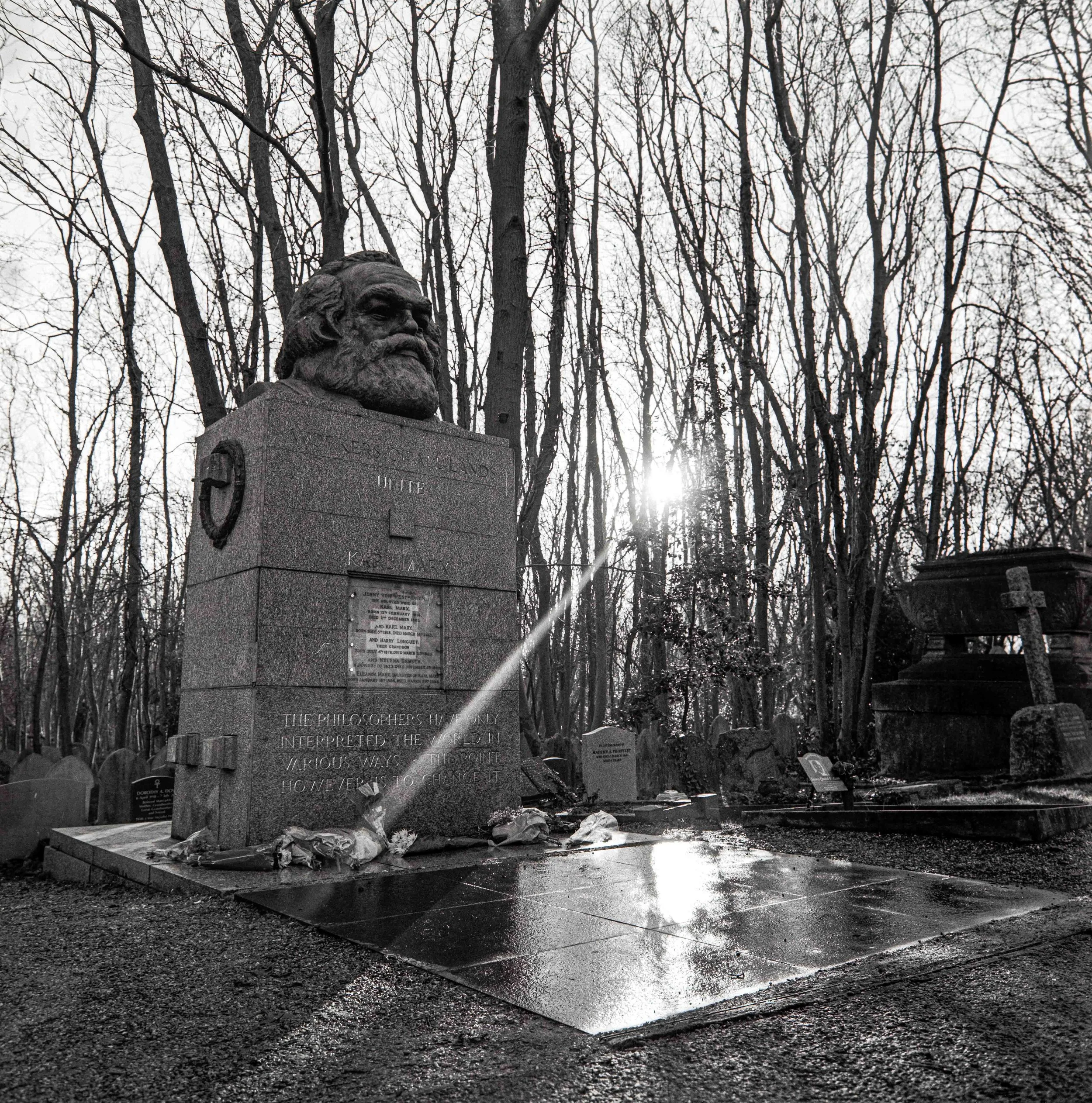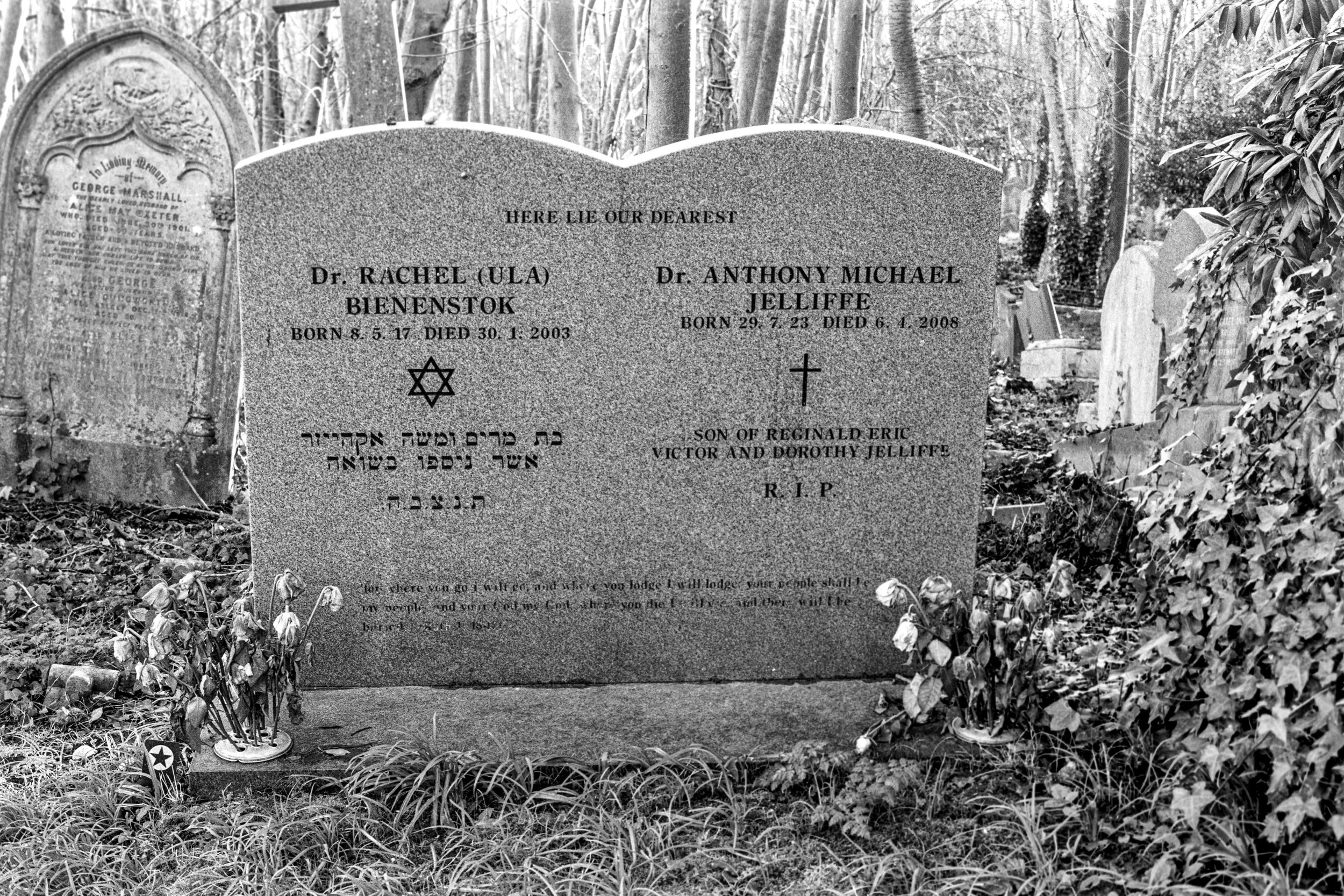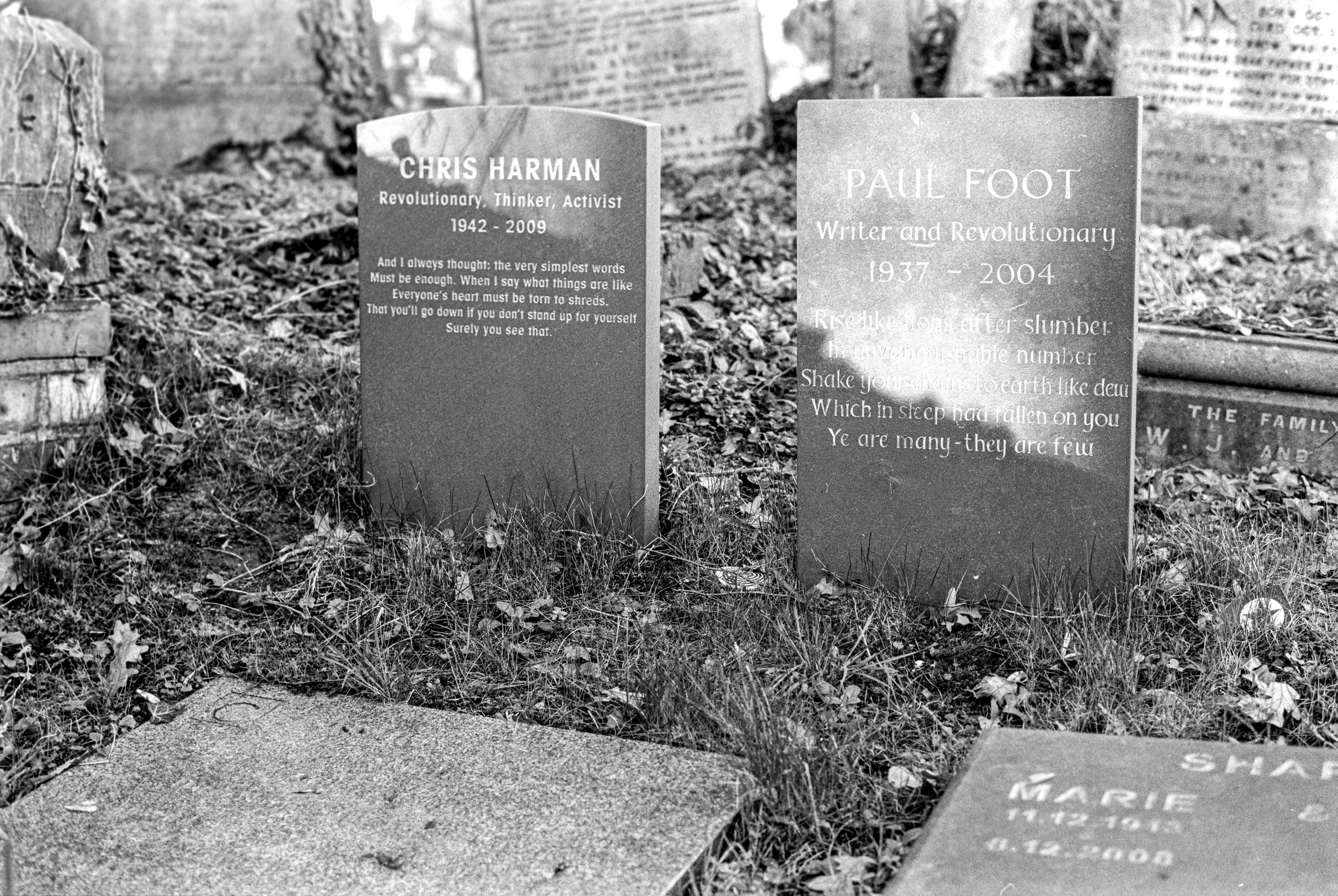Highgate Cemetery
Karl Marx’s impressive bust, though this is not his original grave but a later addition. 15s 50mm F8.0 Fuji Acros 100 II Bronica SQ-A.
London has many large and well-known cemeteries but perhaps the most famous of all (and the one you are most likely to have heard about) is Highgate Cemetery. The first half of the 19th Century saw a population explosion in London as the Industrial Revolution took hold. However, this brought with it many challenges in public health as the populations doubled it little more than a generation. Outbreaks of typhoid and cholera were happening with alarming regulatory, and the number of the dead was too much for the traditional church graveyards to cope with. Bodies were increasingly dug in pitiful shallow graves which left them vulnerable to body snatchers and filled the air with the stink of rotting flesh. Something had to change.
Entering the West Cemetery, notice how enclosed it is with a complete absence of normal headstones. 1/40s 20mm F8.0 Fuji Acros 100 (expired) Nikon F100.
The East entrance shows off how much more open this side is. Beyond the gate is the chapel, through which is the West Cemetery. 1/4s 50mm F8.0 Fuji Acros 100 (expired) Nikon F100 with polariser.
There are actually quite a few Celtic crosses on the East side, again you can see the area looks a lot less enclosed. 1/3s 50mm F8.0 Fuji Acros 100 (expired) Nikon F100 with polariser.
An example of the more impressive monuments that dominate the West side. 1/2.5s 50mm F8.0 Fuji Acros 100 (expired) Nikon F100 with polariser.
In the wake of an Act of Parliament in 1836 many entrepreneurs set about creating private garden cemeteries to cope with the increased demand. The original, what is now the West Cemetery, opened in 1839 and the East Cemetery was opened in 1860 with the site more than doubling in size as demand remained high. To ensure the dead could truly rest in peace, the cemetery was surrounded by tall walls & railings as well as twenty-four hour security of armed retired soldiers.
The Goldhammer Sepulchre is the newest Mausoleum to be built in the West side (2017). The last one built before this was in 1930. 1/60s 50mm F8.0 Fuji Acros 100 (expired) Nikon F100 with polariser.
The Beer Mausoleum is the largest and grandest in the entire cemetery. It was restored in 1993 with funding from English Heritage. 1/2s 110mm F11 Fuji Acros II Bronica SQ-A.
An emblem on one of the cast iron gates. 1/3s 50mm F1.8 Fuji Acros 100 (expired) Nikon F100.
The two sites are very different. The original (west) was built with grandness and splendour in mind, in order to tempt potential customers away from other options, and the architecture was heavily influenced by the big interest in Egyptology of the time. A perfect fit as many of the finds being reported or brought back home were related to death and burials. The later built East side was made to simply house as many graves as possible with only a handful of the large mausoleums you see in the West. While the former has a sense of gothic horror about it, the latter is a much more open and airy space, perhaps more in keeping with a traditional churchyard. What makes this place remarkable (and possible due to not being at a church) is seeing people of different faiths buried side-by-side. Something that is not particularly common, at least in the UK.
An example of people of different faiths buried side-by-side. 1/1.3s 50mm F8.0 Fuji Acros 100 (expired) Nikon F100 with polariser.
The grave of Alexander Litvinenko, Russian dissident poisoned with Polonium in London in 2006. 1/5s 20mm F8.0 Fuji Acros 100 (expired) Nikon F100.
Michael Faraday’s large headstone, his wife is also buried here. 1s 50mm F8.0 Fuji Acros 100 (expired) Nikon F100 with polariser.
Another example of the grander memorials in the West cemetery. Notice how close together they all are. 1/10s 50mm F8.0 Fuji Acros 100 (expired) Nikon F100.
Sadly, during the twentieth century the site fall into a period of steep decline as it was running out of space for further burials and costs increased. The site became neglected and saw increased amounts of vandalism. This all culminated in the most farcical episode in the cemetery’s history in the late 1960s and early 1970s when it was gripped by hysteria of vampires & spectres, stirred up by competing vampire hunters. A mob of occultists descended on 13th March 1970 to witness an exorcism to try and remove this evil presence and later that year a century old grave was even desecrated, with the headless body of a young woman found outsider her broken tomb. The police suspected it was used in a black magic ritual.
Columbarium are places that funerary urns with someone’s cremated remains are stored. 1/3s 50mm F8.0 Fuji Acros 100 (expired) Nikon F100.
The circle of Lebanon, greatly inspired by Egyptology. Walking down the steps into the circle was the most impressice part of my visit. 1/25s 50mm F8.0 Fuji Acros 100 (expired) Nikon F100.
Furthering the theme of Egypt - the Egyptian Avenue leads on from the circle of Lebanon. The tombs inside take direction from the ancient burials of pharaohs. 1/2s 20mm F8.0 Fuji Acros 100 (expired) Nikon F100 with polariser.
The local residents had had enough and wanted more action taken to secure the site out of respect for the dead. In 1975 the Friends of Highgate Cemetery were formed, and they are the charity that runs the site today, collecting money through entrance fees and through the few burial plots still available. Thankfully a huge swathe of restoration work has now occurred to preserve the graves for future generations, and the days of crazed vampire hunters has long passed. There are not many plots left though, and any one of them will require you to part with a five-figure sum. New legislation that has recently received Royal Assent will allow them to investigate re-using old plots that are more than 75 years old without living relatives. As half of the revenue is raised through the selling of plots it will be essential for the long-term future of Highgate.
There were also many Chinese graves in the East Cemetery. 1/20s 50mm F2.8 Fuji Acros 100 (expired) Nikon F100 with polariser.
Graves of different denominations of Christianity can be observed in close proximity. I think these were Catholic graves. 1/3s 50mm F8.0 Fuji Acros 100 (expired) Nikon F100 with polariser.
A memorial to firemen of the London Fire Brigade who lost their lives in the call of duty. 1/4s 20mm F8.0 Fuji Acros 100 (expired) Nikon F100 with polariser.
Unsurprisingly, given its fame and notoriety, there are many famous people buried there with the most well-known being Karl Marx (East) who has been further memorialised by a large bust erected in 1954 by the Communist Party of Great Britain. His grave is by far the most visited and walks are organised by groups most weeks. Other well-known figures include: Michael Faraday (West), Douglas Adams (East), Patrick Caulfield (East) and George Michael (West). You may also recognise the Cemetery from its on-screen appearances, including in the second Fantastic Beasts film. These commercial requests are rarely accepted by the charity, but it generates vital revenue to keep everything maintained.
Marx’s bust is by far the most popular attraction at Highgate Cemetery. 1/8s 50mm F8.0 Fuji Acros 100 (expired) Nikon F100 with polariser.
However it has fallen victim to vandals in the past. The marble plaque was repaired and reinforced glass or perspex to protect it with further damage. 1/5s 50mm F8.0 Fuji Acros 100 (expired) Nikon F100 with polariser.
Many socialists are buried near Marx so as to be close to their political hero. 1/10s 50mm F4.0 Fuji Acros 100 (expired) Nikon F100 with polariser.
Marx’s original grave nearby is very plain and difficult to fine even with the map. 1/5s 50mm F8.0 Fuji Acros 100 (expired) Nikon F100 with polariser.
There’s so much more that can be written about this place, but I think it’s best if you simply visit yourself. Both sides are now opened for people to wonder around on their own, but the West side also has historical tours that give visitors a better insight into the cemetery’s trials and tribulations. I didn’t manage to get on one when I went but I’ll have to get on one next time. For now, I hope you enjoy the images I’ve taken and perhaps it will inspire you to visit in the not-too-distant future. Though I strongly recommend you leave the garlic and wooden stakes at home.
Paul Caulfield’s self-designed and straight to the point headstone. 4s 50mm F8.0 Fuji Acros II Bronica SQ-A.
The sun sets on the East Cemetery, this part felt the most like a traditional church graveyard. 1/8s 50mm F8.0 Fuji Acros 100 (expired) Nikon F100 with polariser.
If you enjoyed this blog then please consider leaving a tip below.























